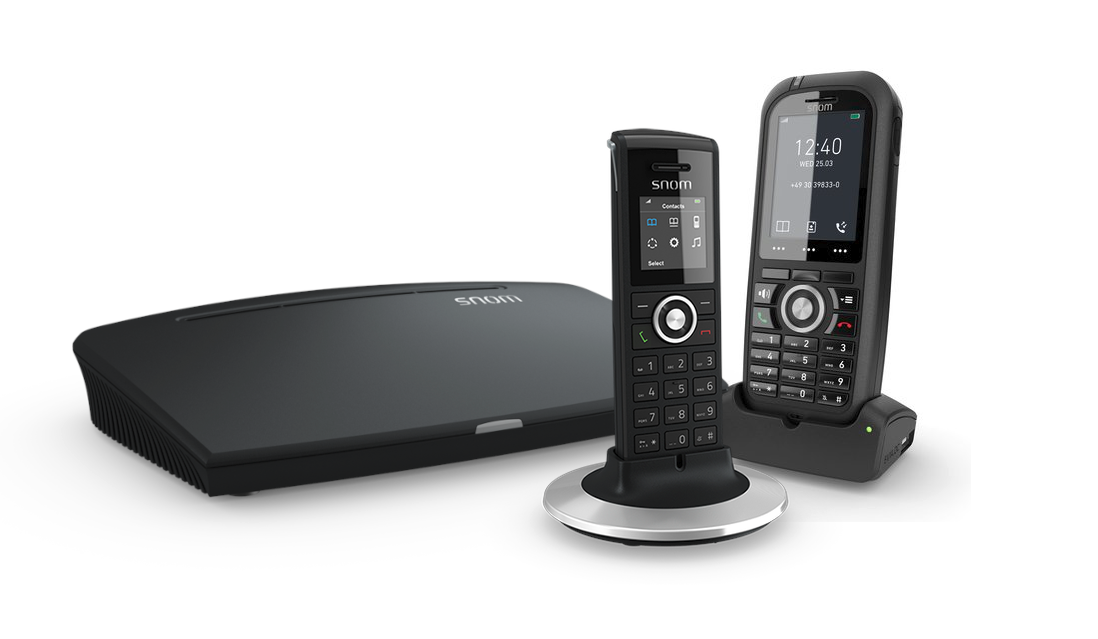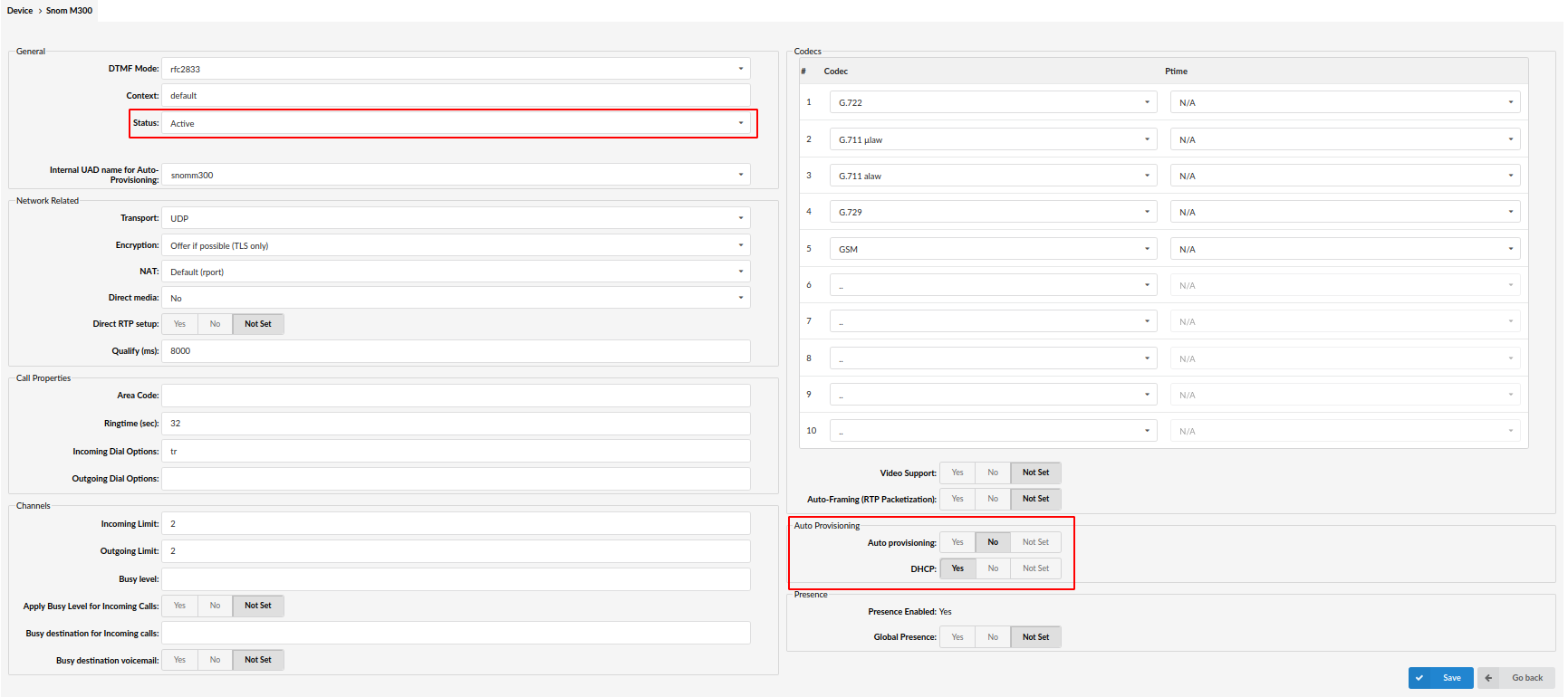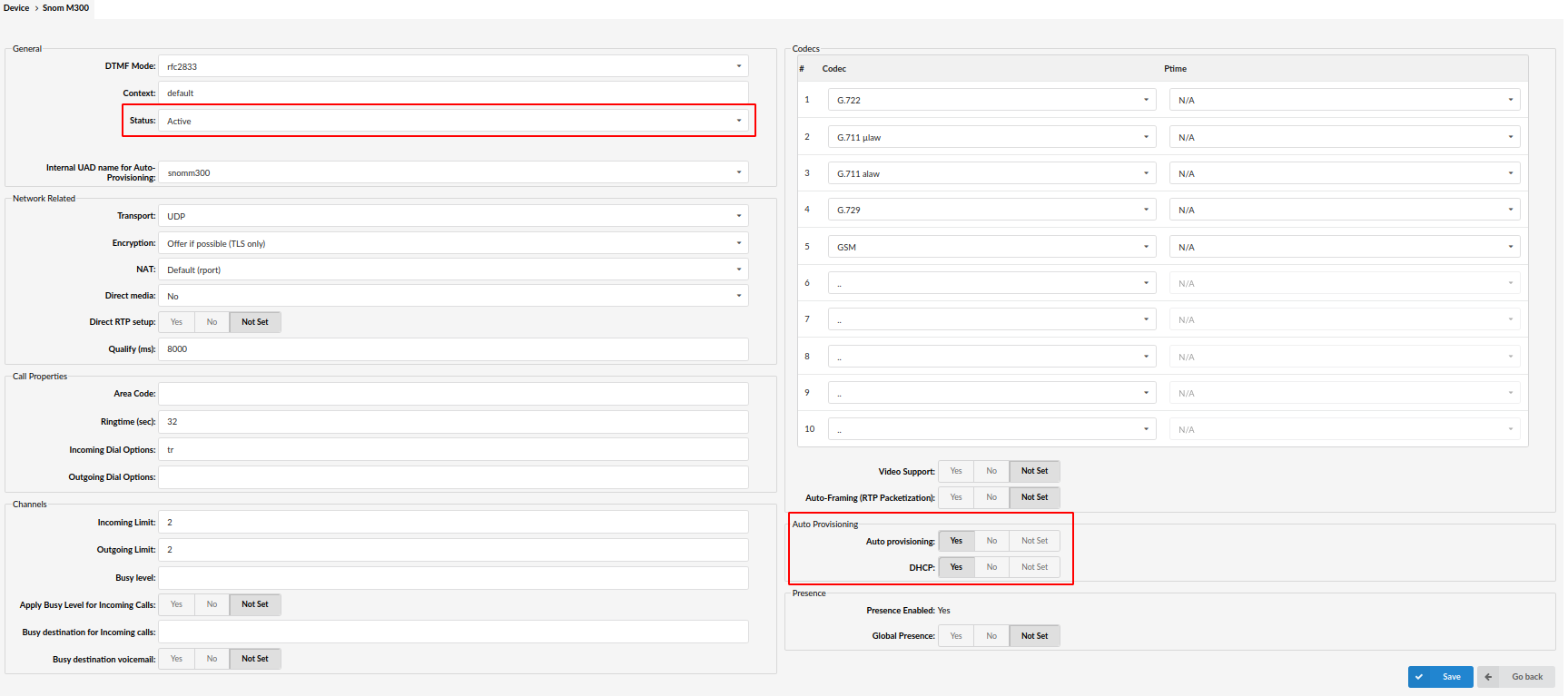¶ Introduction

This Configuration Guide is written as a general guide on how to configure the Snom DECT base station M300 to work with PBXware 5.3.8.
¶ Requirements
¶ Identifying Device Model
To start and successfully complete the registration of your Snom device, you need to know which device model to set up.
On the back of each Snom device, there is model information that you should check. Although various device models can have exactly the same requirements and installation procedures, device models can also have significantly different requirements and installation procedures, so that is why it is important to know the model you own which results in you setting up the device successfully.
¶ DECT Base Station Firmware
- Make sure that your Snom DECT base station is loaded with an appropriate firmware version, IPDECT-V2/05.00/B0001.
- To find out the firmware version of your Snom DECT base station, open a new browser window and enter your DECT base station's IP address in order to access the web administration interface login screen. Example: http://192.168.1.22.
- Go to Home/Status in the left navigation menu.
¶ Supported DECT Handsets
The two supported DECT handsets are as follows:
- M25
- M80
Additionally, the Snom M300 DECT base station is also compatible with other DECT handsets: M65, M70, M85, and M90.
NOTE: Please note that DECT handsets have their own firmware. It is highly recommended that DECT base stations and DECT handsets use the same firmware version.
For more on how to upgrade firmware and their versions, please visit: https://service.snom.com/display/wiki/DECT+M-Series+Firmware.
¶ DHCP Server
Fully configured and operational DHCP server.
¶ PBXware Version
PBXware version 5.3.8
In order to find out the PBXware version:
- Log in to PBXware
- Navigate to Settings: About.
On the top of About page, you may see a code similar to this one PBXware Edition: Multi-Tenant Release: 5.3.8.0 (251dc1c5) Running: 13.23.1-gc-040bbaca, Proxy v5.3.8 (231c5f3), API: 5.3, libmemcached version: 1.0.18, where Release denotes the current version of your PBXware.
¶ Installation
This section describes how to install and connect the device to the electrical power and data network as well as how to apply factory settings.
The following topics are covered:
- Power Adapter
- Factory Settings
¶ Power Adapter
Connect the Network
- Connect the DC plug on the power adapter to the DC port on the device and connect the other end of the power adapter into an electrical power outlet.
- Connect the Ethernet cable between the Internet port on the device and the network port on a router or switch to access LAN.
¶ Power over Ethernet (PoE)
Please note that the Snom DECT base station M300 does not support Power over Ethernet (PoE).
¶ Find the Device's IP Address
To determine the IP address of the DECT M-Series base station, users can utilize one of the compatible handsets (M25, M65, M70, M80, and M85).
Please do the following:
1. On the M25 DECT handset, press the 'OK' key in the center of the navigation key and the 'Menu' key on the M80 DECT handset
2. Dial *47*
3. Select the desired base station.
The IP address will be displayed on the top of the display.
¶ Reset to Factory Settings
To reset to the factory settings, simply use a paper clip or something similar and press the reset button for 10 seconds or until the LED changes to a solid red light.
NOTE: Do not unplug or remove power to the device while it is updating firmware and configuration.
NOTE: After the factory reset, the device language and timezone must be selected before registering the device.
¶ Registering Device
This section describes how to identify the Snom device model, requirements that must be met, and how to register a device using manual configuration or auto provisioning.
The following topics are covered:
- Manual Configuration
- Auto Provisioning
¶ Manual Configuration
This section describes how to set UAD settings, create a PBXware Extension and register the device.
The following topics are covered:
- UAD Settings
- Creating an Extension
- Registering a Device
¶ UAD Settings

Log in to the PBXware's web administration interface
- Open a new browser window and enter the IP address in order to access the PBXware web administration login screen. Example: http://192.168.1.10.
- Log in to PBXware with your e-mail address and password.
UAD settings
- Navigate to Settings: UAD.
- Make sure that the Snom UAD is enabled. To check the UAD status, click the Edit icon corresponding to your Snom device.
- Make sure Status is set to Active, Auto provisioning is set to No, and DHCP is set to Yes.
- Click the Save button to save changes.
¶ Creating an Extension

Add the Extension
- Navigate to Extensions. Click the Add Extension button.
- The standard options window will be shown below.
- Select the Snom device model from the UAD select box.
- Select Location: Local or Remote.
Local is for all Extensions registered on the LAN and Remote is for all Extensions registered from remote networks, WAN, Internet etc.
- Click the Next step button.
Extension Values
Enter values into the required field text boxes.
REQUIRED FIELDS:
- Name
Enter a name for the Extension being created. Example: John Smith.
Enter the e-mail address associated with this Extension. This e-mail address will receive all system notification messages. Example: john.smith@bicomsystems.com
- Click the Save button.
¶ Registering a Device
This section describes how to register the Snom device using Hostname or IP Address.
¶ Hostname or IP Address
Log in to the device's web administration interface
After logging, navigate to the Servers tab in the left menu and add a server.
To add a server, please populate the following fields:
- Server Alias
Enter the alternate name for a host
- Registrar
Enter the Hostname or IP Address of the PBXware.
- Example for Hostname: voip.bicomsystems.com
- Example for IP Address: 192.168.1.10
To add the Extension, please navigate to the Extensions tab. Please refer to the list of the required fields:
REQUIRED FIELDS:
- Line Name
PBXware Extension name. Example: John
- Extension
PBXware Extension number. Example: 103.
- Authentication Username
PBXware Extension number. Example: 103.
NOTE: Please note that 'Extension' and 'Authentication Username' share the same data.
- Authentification Password
The Secret of the Extension as received in the e-mail associated with this Extension. Example: _%Z4M3*Ts9y7. A password is generated automatically for each newly created Extension.
- Display Name
Name that will be displayed on the handset
- Server
Select a previously created server from the drop-down menu
- Click the Save button.
Once the configuration for an Extension is set up, a user may proceed with configuration for handsets. To do so, please follow the steps:
1. In the table on the Extensions page, check the box to the left of the Idx and then click on Register Handset(s)
2. On the M25 DECT handset, press the 'OK' key in the center of the navigation key and the 'Menu' key on the M80 DECT handset
3. Select 'Connectivity'
NOTE: To register the handset at the base, "Register" must be selected.
NOTE: M80 allows a user to register the handset for up to 10 Extensions. The Extensions must be on different SIP servers, and each Extensions can only be registered for and by one handset in the system.
4. Select the first line with the word "Empty" line
5. Enter the access code and confirm
NOTE: The default code is 0000.
6. In the table on the Extensions page, check the box to the left of the VoIP Idx and click 'Start SIP Registration(s)'.
Once registration has been completed, the account/Extension will be shown on the display.
¶ Auto Provisioning
This section describes how to set UAD settings, create a PBXware Extension and register the device using DHCP or Static IP address.
The following topics are covered:
- UAD Settings
- Creating an Extension
- Registering a Device
¶ UAD Settings

Log in to the PBXware's web administration interface.
- Open a new browser window and enter the IP address in order to access the PBXware's web administration login screen. Example: http://192.168.1.10.
- Log in to PBXware with your e-mail address and password.
UAD settings.
- Navigate to Settings: UAD.
- Make sure that Snom UAD is enabled. To check the UAD status, click the Edit icon corresponding to your Snom device.
- Make sure that Status is set to Active, Auto provisioning is set to Yes, and DHCP is set to Yes.
- Click the Save button to save changes.
¶ Creating an Extension

Add Extension
- Navigate to Extensions. Click Add Extension.
- The standard options window will be shown below.
- Select the Snom device model from the UAD select box.
- Select Location: Local or Remote.
Local is for all Extensions registered on the LAN and Remote is for all Extensions registered from remote networks, WAN, Internet etc.
- Click the Next step button.
Extension values
Enter values into the required field text boxes.
REQUIRED FIELDS:
- Name
Enter a name for the Extensions being created. Example: John Smith.
Enter the e-mail address associated with this Extensions. This e-mail address will receive all system notification messages. Example: john.smith@bicomsystems.com
- Auto Provisioning
Set to Yes.
- MAC Address
Enter the Snom device's MAC address. Example: 000413123456. The MAC address can be found at the back of the device.
- Click the Save button.
¶ Registering a Device
This section describes how to register a Snom device using DHCP and TFTP or HTTP.
The following topics are covered:
- DHCP
- TFTP or HTTP
¶ DHCP
Configure DHCP
- Make sure that your DHCP router is configured to use option 66 to automatically instruct devices with the URL for auto provisioning. For more information, please refer to your router documentation or contact your network administrator.
Device's first boot or user-initiated reboot
- The auto provisioning process will start during the device's first boot or after the reboot process has been initiated by the user. DHCP server will instruct the device from where to pick up the appropriate configuration file. If everything is done as described above, you should have successfully registered your device to PBXware.
Dial *123 to verify registration.
¶ TFTP or HTTP & HTTPS
- Open a new browser window and enter your device's IP address, e.g. http://192.168.1.22.
- Click the Management tab in the left menu.
- Enter Auto Provisioning username and password into the HTTP Management User and HTTP Management Password.
- Choose what server type you intend to use: HTTP, HTTPS or Trivial FTP. NOTE: Our recommendation is to use HTTP.
- Into Configuration Server Address enter http:// followed by a Hostname or an IP Address, followed then by /prov/snomm300-{mac}.xml
Example for a Hostname using HTTP: http://abc.bicomsystems.com/prov/snomm300-{mac}.xml
Example for an IP Address using HTTP: http://192.168.1.10/prov/snomm300-{mac}.xml
- Click Save.
- Click Save and reboot
- If you decide to use server type HTTPS, into Configuration Server Address enter https:// followed by a Hostname or an IP Address, followed by /snomm300-{mac}.xml
Example for Hostname: https://voip.bicomsystems.com/snomm300-{mac}.xml
Example for IP Address: https://192.168.1.10/snomm300-{mac}.xml
- Click Save.
- Click Save and reboot
NOTE: After configuration updated, you will need to access the phone's GUI again.
Click the Servers tab in the left menu.
For Secure RTP you will need to manually change option from Enable to AUTO.
Click Save.
- If you decide to use server type TFTP, into Configuration Server Address enter tftp:// followed by a Hostname or an IP Address, followed by /snomm300-{mac}.xml
Example for Hostname: tftp://voip.bicomsystems.com/snomm300-{mac}.xml
Example for IP Address: tftp://192.168.1.10/snomm300-{mac}.xml
- Click Save.
- Click Save and reboot
- A pop-up window will show up, click OK to confirm your action and to reboot the device.
- You will have to wait a couple of seconds for the configuration to be updated. NOTE: Do not power off your device.
- The auto provisioning process will start during the device's reboot process. The device will pick up the appropriate configuration file from PBXware. If everything is done as described above, you should have successfully registered your device to PBXware.
Dial *123 to verify registration.